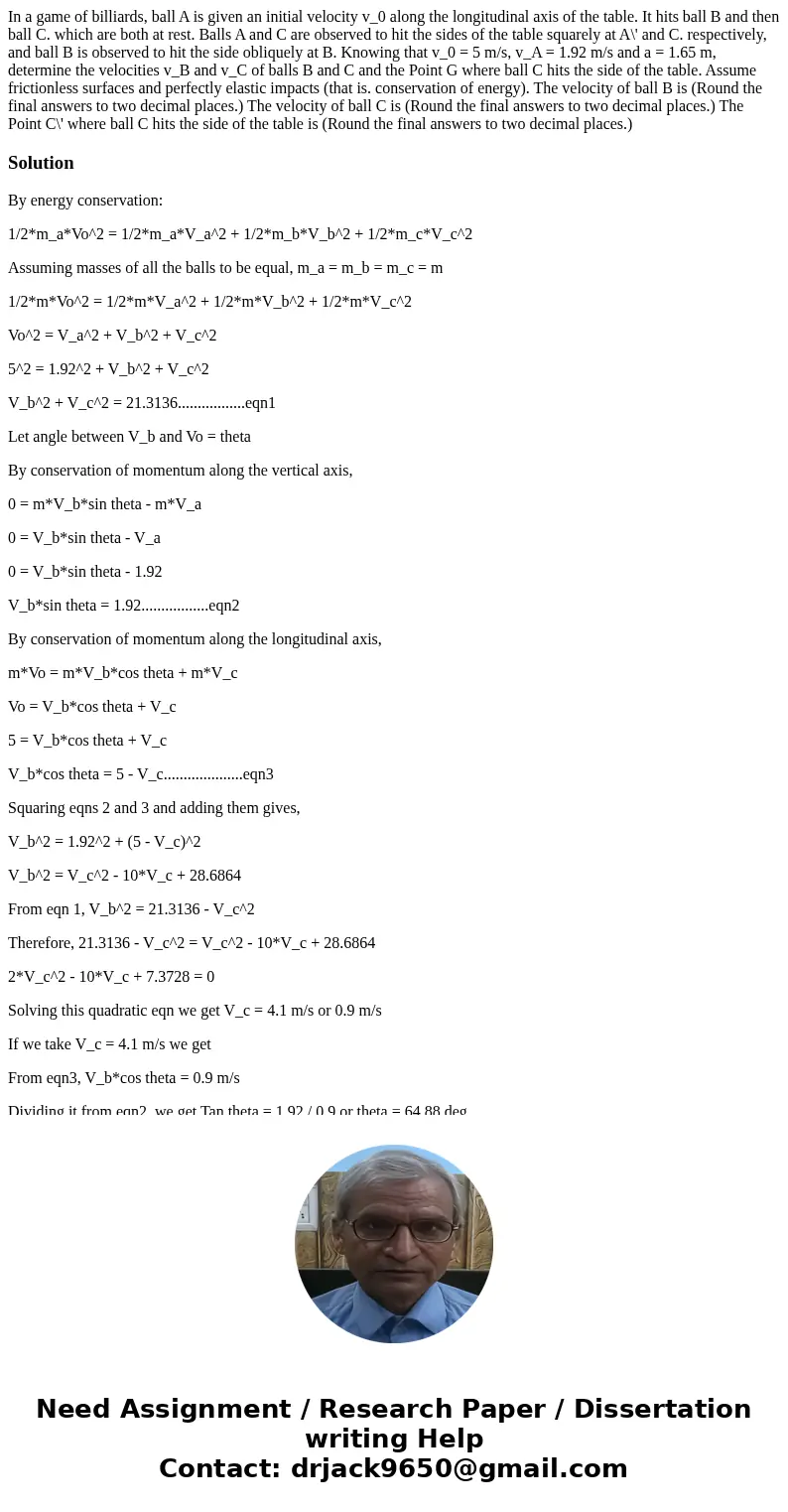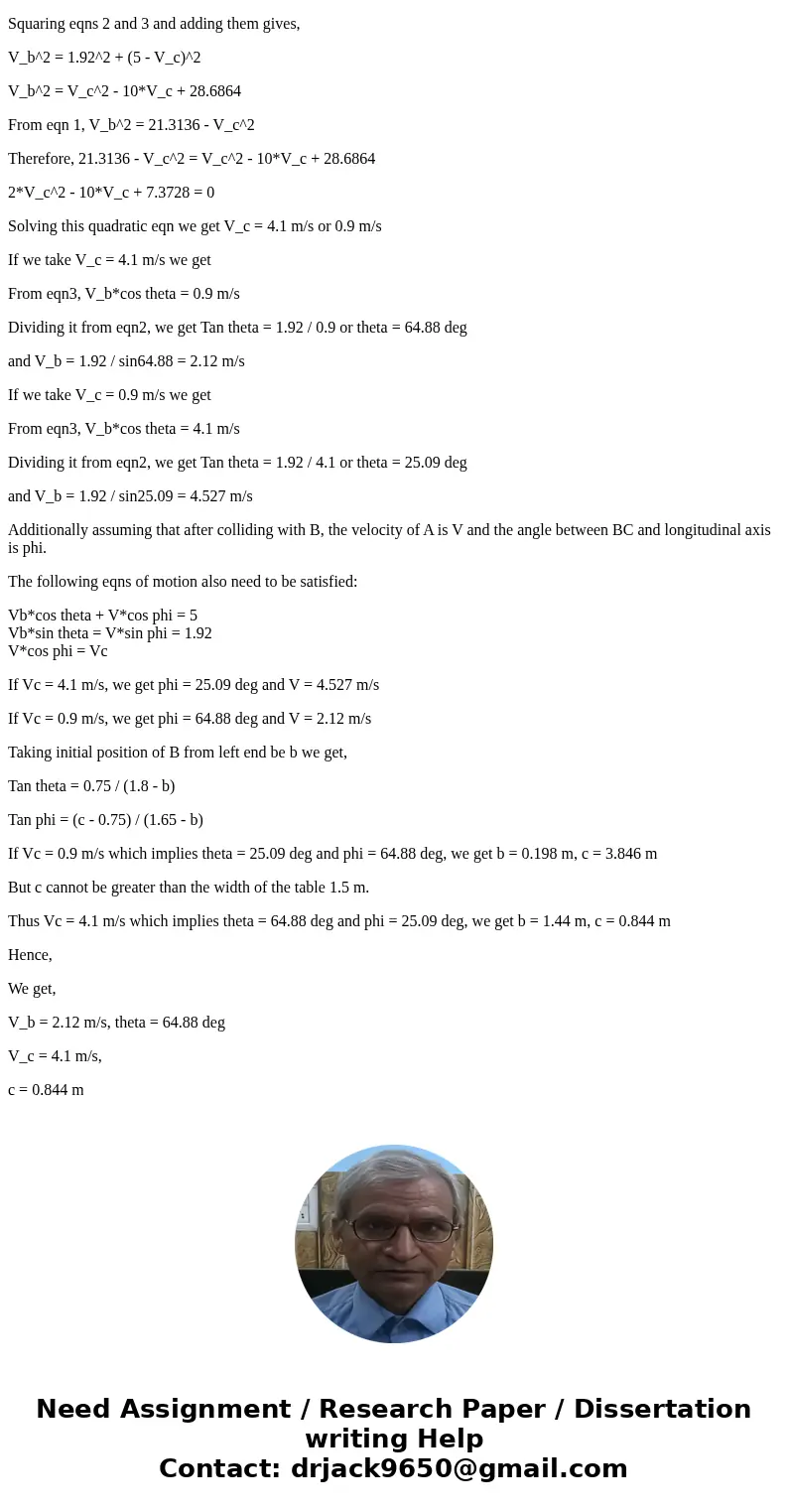In a game of billiards ball A is given an initial velocity v
Solution
By energy conservation:
1/2*m_a*Vo^2 = 1/2*m_a*V_a^2 + 1/2*m_b*V_b^2 + 1/2*m_c*V_c^2
Assuming masses of all the balls to be equal, m_a = m_b = m_c = m
1/2*m*Vo^2 = 1/2*m*V_a^2 + 1/2*m*V_b^2 + 1/2*m*V_c^2
Vo^2 = V_a^2 + V_b^2 + V_c^2
5^2 = 1.92^2 + V_b^2 + V_c^2
V_b^2 + V_c^2 = 21.3136.................eqn1
Let angle between V_b and Vo = theta
By conservation of momentum along the vertical axis,
0 = m*V_b*sin theta - m*V_a
0 = V_b*sin theta - V_a
0 = V_b*sin theta - 1.92
V_b*sin theta = 1.92.................eqn2
By conservation of momentum along the longitudinal axis,
m*Vo = m*V_b*cos theta + m*V_c
Vo = V_b*cos theta + V_c
5 = V_b*cos theta + V_c
V_b*cos theta = 5 - V_c....................eqn3
Squaring eqns 2 and 3 and adding them gives,
V_b^2 = 1.92^2 + (5 - V_c)^2
V_b^2 = V_c^2 - 10*V_c + 28.6864
From eqn 1, V_b^2 = 21.3136 - V_c^2
Therefore, 21.3136 - V_c^2 = V_c^2 - 10*V_c + 28.6864
2*V_c^2 - 10*V_c + 7.3728 = 0
Solving this quadratic eqn we get V_c = 4.1 m/s or 0.9 m/s
If we take V_c = 4.1 m/s we get
From eqn3, V_b*cos theta = 0.9 m/s
Dividing it from eqn2, we get Tan theta = 1.92 / 0.9 or theta = 64.88 deg
and V_b = 1.92 / sin64.88 = 2.12 m/s
If we take V_c = 0.9 m/s we get
From eqn3, V_b*cos theta = 4.1 m/s
Dividing it from eqn2, we get Tan theta = 1.92 / 4.1 or theta = 25.09 deg
and V_b = 1.92 / sin25.09 = 4.527 m/s
Additionally assuming that after colliding with B, the velocity of A is V and the angle between BC and longitudinal axis is phi.
The following eqns of motion also need to be satisfied:
Vb*cos theta + V*cos phi = 5
Vb*sin theta = V*sin phi = 1.92
V*cos phi = Vc
If Vc = 4.1 m/s, we get phi = 25.09 deg and V = 4.527 m/s
If Vc = 0.9 m/s, we get phi = 64.88 deg and V = 2.12 m/s
Taking initial position of B from left end be b we get,
Tan theta = 0.75 / (1.8 - b)
Tan phi = (c - 0.75) / (1.65 - b)
If Vc = 0.9 m/s which implies theta = 25.09 deg and phi = 64.88 deg, we get b = 0.198 m, c = 3.846 m
But c cannot be greater than the width of the table 1.5 m.
Thus Vc = 4.1 m/s which implies theta = 64.88 deg and phi = 25.09 deg, we get b = 1.44 m, c = 0.844 m
Hence,
We get,
V_b = 2.12 m/s, theta = 64.88 deg
V_c = 4.1 m/s,
c = 0.844 m


 Homework Sourse
Homework Sourse